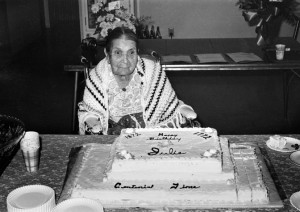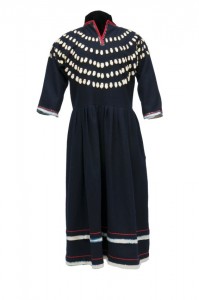
Born in 1872 on the South Fork of the Sun River, Julia Ereaux was the daughter of a French immigrant, Lazare “Curley” Ereaux, and his A’a Ni Nin (White Clay—also known as Gros Ventre) wife, Pipe Woman. Julia, whose White Clay name was Sweet Pine, grew up in a bicultural family and was fluent in French, English, and Gros Ventre. She became a rancher and a newspaper correspondent, even as she served as a Fort Belknap tribal council member, promoted traditional indigenous arts, and worked to prevent the spread of tuberculosis on the reservation. A founding member of one of the first Indian women’s clubs in Montana, Schultz devoted her life to the well-being of the A’a Ni Nin people.
By the time Julia was born, her parents had already lost two children to a smallpox epidemic that took the lives of hundreds of American Indians in what is now north-central Montana. Along with several other mixed-heritage families, the Ereaux family settled near Augusta and took up farming. They were so poor, Julia later recalled, that her mother had to cut and thresh the grain by hand.
Julia received her schooling at St. Peter’s Mission School, an Indian boarding school in the Sun River Valley, which was attended by many Blackfeet and Métis children. Run by Ursuline nuns, the school also employed two famous Montanans during Julia’s years there: Mary Fields, a former slave who worked as handyman and gardener for the school and who became Montana’s first female postal carrier, and Louis Riel, one of the Métis leaders of the Northwest Rebellion of 1885.
After finishing her education, Julia helped her family to build a ranch on her mother’s allotment on the Fort Belknap Reservation and assisted at St. Paul’s Mission School, where her sisters were educated. Then, in 1890, she married German immigrant Al Schultz, and the couple moved with her parents to a ranch near Dodson.
Julia Schultz spent her life working to improve conditions on the Fort Belknap Reservation, particularly combatting the spread of tuberculosis. From the 1880s through the 1950s, Montana’s tribes experienced an extended epidemic of tuberculosis. The overcrowding in many Indian families’ single-room cabins, combined with widespread malnutrition and lack of medical care on the reservation, created fertile ground for the disease.

With Montana’s public health nurse, Henrietta Crockett, Schultz formed an Indian women’s club at Fort Belknap, one of only two such clubs in the state in the 1920s, and through the club she spearheaded projects to educate tribal members about the causes and spread of TB. It was a cause she also championed during her three years on the tribal council in the mid-1930s.
Schultz also served on the Indian Welfare Committee of the Montana Federation of Woman’s Clubs, seeking to bring statewide attention to the dire living conditions on the reservations. With members of the Crow Indian Women’s Club, Schultz gathered information about the prevalence of tuberculosis on the reservations and then presented the data to the Montana State Tuberculosis Association. Henrietta Crockett and members of other Montana women’s clubs joined the Indian clubwomen in lobbying for hospitals on the reservations, since the nearest hospitals were generally too far to be of use to tribal members—and some hospitals did not admit Indians.
Schultz also shared the history and culture of the Gros Ventre people with non-Indians, particularly members of non-Indian women’s clubs. In 1930 she won a national essay contest sponsored by the General Federation of Women’s Clubs for her essay on Gros Ventre history and culture. The essay ended with a reminder to Euro-Americans of the many kindnesses shown their ancestors by indigenous people and an impassioned plea for reciprocal compassion.
During the Great Depression, Schultz used her creativity and resourcefulness to help American Indian families survive the hard times. She taught gardening and food-preservation techniques, possibly learned from Mary Fields at St. Peter’s mission, to women on the Fort Belknap Reservation, and she and other women collected the discarded army uniforms that were shipped in boxcars to the Indian reservations. They washed, repaired, and distributed the uniforms that were still in good condition; the remainder they recycled into wool quilts to be shared with families who needed them. Schultz said she once washed, dried, and mended an entire boxcar’s worth of uniforms by herself, a task that must have taken days.
From 1936 until 1942, Schultz also led a Works Progress Administration program to revive traditional arts and crafts of the White Clay and Assiniboine tribes. The Indian Arts and Crafts Act, passed in 1934, inspired a renewed investment in the traditional artistic skills of indigenous people and created a market for authentic Indian-made products. At Fort Belknap, she organized elderly women, who still retained the skills and knowledge of traditional designs, to share this information with younger women. These efforts enabled the women to sell their creations—such as beadwork, quillwork, parfleche containers, and leather goods—for much-needed cash.
At age seventy, Schultz joined the reporting staff of the Phillips County News, where she worked for the next twenty years. During this time, she continued to advocate for tuberculosis education and improved medical services for Montana’s Indian population, and to promote Native arts and cultural preservation. Celebrated by Indians and non-Indians alike as a cultural and community leader, Julia Schultz lived to be 104 years old. LKF
Sources
Costello, Gladys. “Oldest News Staff Member Observes 90th Birthday.” Phillips County News (Malta, Mont.), September 9, 1962: 1, 12.
“Helena’s Women’s Club Will Hear Talk by Mrs. Julia Schultz.” Helena (Mont.) Independent Record. October 11, 1951: 10.
“Julia Schulz [sic] Had Long and Interesting Life” (obituary). Phillips County News, September 15, 1972.
“150 Will Attend Tuberculosis Meetings Today.” Helena (Mont.) Independent Record. April 19, 1941: 1-2.
Schultz, Julia E. “The Gros Ventres Tribe of the Blackfoot Nation.” In Prize Essays on the Traditional Background of the Indians, complied by Mrs. Joseph Lindon Smith. Division of Indian Welfare, General Federation of Women’s Clubs, Department of Public Welfare. October 1930: 5-14
Stallcop, Emmett A. “Julia Schulz Biography.” Undated, unpublished manuscript in Emmett A. Stallcop Papers, MHS, SC 727, Montana Historical Society, Helena.
For my story of Curley Ereaux and Pipe Woman see:
http://fortbenton.blogspot.com/2009/07/curley-ereaux-medicine-pipe.html
Aunt Julia is my great-Aunt, the sister to my Grandfather Frank Ereaux. I can still see her in her long dress, wearing her little hat, and using her cane while making her rounds gathering the news in the Dodson Community. I loved to visit her in her little home in Dodson where she was always busy with her writing and her crafts. Since I loved to write at an early age, she seemed to take a special interest in me, and visa versa. She was, and still is, an inspiration. Thank you for sharing the history of our great-Aunt Julia Ereaux Shultz. I would like to make copies for our family members who don’t have a computer…how do I do that???? Again, thanks.
I’m glad you found the site! Thank you for sharing your memories of your great aunt. You are welcome to print the story directly from the website. (Just select “control P”). We are gathering all the stories into a book that will be out this winter (spring 2016 at the latest.) Your aunt will be included, of course.
So is Julia white/shultz/Ereaux a dependent of Fred White the 1st & 2nd ? just wondering cause my honey and I just arrived here alin chinook this evening to check out his res for the first time for the next week. Just thought it was cool I stumbled across this article of such am inspiring women.
If you happen to get this mess. Any advice or places of interest for the family has history would be appreciated.
We don’t have any information that points to a connection between Julia Ereaux Schultz and Fred White–but we haven’t done much research into her genealogy either. Sorry not to be of more help.
Ashley Lovett – Julia Schultz was my Grandfather’s aunt. As far as I know from my family tree research, she would not have been directly related to the Whites. The confusion probably stems from the alternative name for the A’a Ni Nin people, White Clay or Gros Ventre. She was my great-grandmother, Cecelia Ereaux Minughs’ sister. We called her “Grandma Julia”.